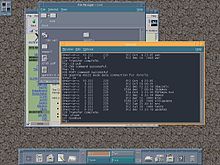Guide to X11/Window Managers/dtwm
Appearance

dtwm -- The CDE Window Manager
[edit | edit source]The dtwm window manager is based upon the Motif window manager, mwm. It is an integral part of the Common Desktop Environment and enables access to other components in the CDE Desktop Environment. dtwm also provides workspace management of multiple desktops.
History
[edit | edit source]Features
[edit | edit source]Features of the dtwm window manager include:
- Stacking windows
- Support for multiple desktops
- Window decorations (including borders and a titlebar with titlebuttons)
- "Shaped" windows
- Support for XToolkit clients (uses XLib and XResources)
- Support for Motif
- Support pop-up menus by titlebuttons, pointer(mouse) buttons or keyboard
- support for icon management
- Support for themes and customized colors
- Support for desktop wallpaper
Using
[edit | edit source]Normally, the session manager dtsession starts up dtwm. You can alter the command line for the window manager via the wmStartupCommand resource for the session manager (see dtsession(1) ). Similarly, you can affect the behavior of dtwm by saving resources for dtwm as part of your session.
Default dtwm window frames have distinct components with associated functions:
- Title Area
- In addition to displaying the client’s title, the title area is used to move the window. To move the window, place the pointer over the title area, press button 1 and drag the window to a new location. By default, a wire frame is moved during the drag to indicate the new location. When the button is released, the window is moved to the new location.
- Title Bar
- The title bar includes the title area, the minimize button, the maximize button, and the window menu button. In shaped windows, such as round windows, the title bar floats above the window.
- Minimize Button
- To turn the window into an icon, click button 1 on the minimize button (the frame box with a small square in it).
- Maximize Button
- To make the window fill the screen (or enlarge to the largest size allowed by the configuration files), click button 1 on the maximize button (the frame box with a large square in it).
- Window Menu Button
- The window menu button is the frame box with a horizontal bar in it. To pull down the window menu, press button 1. While pressing, drag the pointer on the menu to your selection, then release the button when your selection is highlighted. Pressing button 3 in the title bar or resize border handles also posts the window menu. Alternately, you can click button 1 to pull down the menu and keep it posted; then position the pointer and select. You can also post the window menu by pressing
<Shift>-<Esc>or<Alt>-<Space>. Double-clicking button 1 with the pointer on the window menu button closes the window. - Default Window Menu
- Restore - Restores the window to its size before minimizing or maximizing.
- Move - Allows the window to be moved with keys or the mouse.
- Size
- Minimize
- Maximize
- Lower - Moves window to bottom of window stack.
- Occupy Workspace... - Display the Occupy Workspace dialog to change the workspaces in which the window appears.
- Occupy All Workspaces
- Unoccupy Workspace - Remove the window from the current workspace as long as the window is in more than one workspace.
- Close
- Resize Border Handles
- To change the size of a window, move the pointer over a resize border handle (the cursor changes), press button 1, and drag the window to a new size. When the button is released, the window is resized. While dragging is being done, a rubber-band outline is displayed to indicate the new window size.
